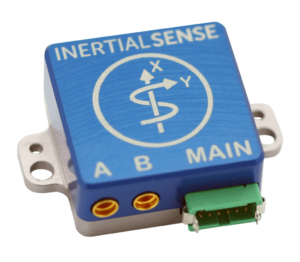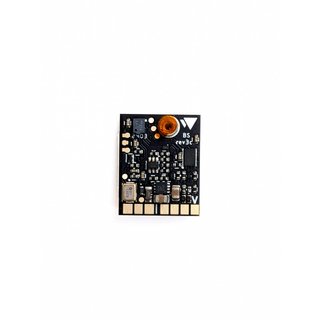Why Choose SparkNavi Drone Flight Controller and GNSS/INS Made in Taiwan for Advanced Navigation
Why Choose SparkNavi Drone Flight Controller and GNSS/INS Made in Taiwan for Advanced Navigation
Blog Article
Discovering the Role of Drone Flight Controllers in Enhancing Trip Security and Navigation Effectiveness
The innovation of drone technology has actually considerably boosted the significance of trip controllers, which offer as the mind of these airborne vehicles. By integrating real-time data from a range of sensors, trip controllers enhance trip security and navigation efficiency, ensuring that drones can run efficiently also in intricate atmospheres.

Understanding Flight Controllers
Trip controllers are important parts in the functioning of drones, functioning as the minds that manage and support trip procedures. These sophisticated devices process information from different sensors, consisting of accelerometers, gyroscopes, and GPS, to make certain that the drone maintains its designated trip path. The trip controller analyzes this data and implements commands based upon pre-defined formulas, enabling the drone to react to ecological adjustments, such as wind or challenges.
The main function of a flight controller is to maintain security during trip. It attains this by making real-time adjustments to the drone's motors and control surface areas, making certain equilibrium and control. In addition, contemporary trip controllers integrate innovative attributes such as waypoint navigation, enabling automated flight courses and improved functional effectiveness.
Recognizing the style of flight controllers is vital for both specialists and hobbyists. They typically contain a microcontroller, firmware, and various user interfaces for sensing unit input and interaction. As modern technology breakthroughs, flight controllers have ended up being more capable and portable, integrating expert system to adapt and improve decision-making processes to complex flight scenarios. This evolution represents a pivotal development in the drone sector, paving the method for much more sophisticated applications and more secure operations.
Secret Parts of Trip Stability
Accomplishing optimum flight stability in drones depends on numerous essential elements that function in concert to guarantee smooth and regulated operations. Central to this stability is the flight controller itself, which refines information from numerous sensing units to maintain the preferred trip perspective. This includes accelerometers and gyroscopes that determine motion and positioning, permitting real-time changes to the drone's placement.
Another essential component is the electronic speed controllers (ESCs), which control the power provided to the motors. By finely adjusting electric motor rates in response to flight controller commands, ESCs help maintain balance and counteract disturbances triggered by wind or unexpected motions.
In addition, the layout of the drone's framework plays an essential duty in trip security. A well-structured framework lessens resonances and improves the general aerodynamic profile, adding to smoother flight qualities. The assimilation of innovative formulas within the trip controller help in predictive adjustments, guaranteeing a adaptable and responsive trip experience.
With each other, these elements form a natural system that improves a drone's stability, permitting specific maneuvering and enhanced performance in different trip problems.
Navigation Performance Methods
Effectiveness in navigation is essential for maximizing drone operations, particularly in complicated atmospheres. Effective navigation methods boost the capability of drones to traverse difficult surfaces and prevent barriers, thus boosting operational performance and security.
One prominent method is the execution of sophisticated general practitioners and inertial measurement devices (IMUs) that offer specific place tracking and alignment data. These modern technologies allow drones to determine optimum flight courses in real-time, considering different variables such as wind conditions and possible obstacles.
One more strategy entails making use of formulas for path planning and optimization. Formulas such as A * and Dijkstra's algorithm can be deployed to determine the most effective course while reducing power intake and flight time. Incorporating machine learning designs can allow drones to adaptively discover from their atmospheres, boosting navigating capacities via experience.

Effect On Autonomous Drones
The assimilation of advanced navigation techniques has profoundly transformed the capabilities of independent drones, allowing them to operate with greater autonomy and accuracy. SparkNavi drone flight controller and GNSS/INS made in taiwan. These improvements are primarily associated to innovative trip controllers that make use of real-time information handling and sensing unit combination, enabling drones to browse complicated atmospheres effortlessly
The effect on self-governing drones prolongs beyond mere navigation; it incorporates boosted barrier evasion, enhanced security during dynamic problems, and raised goal dependability. By leveraging algorithms that incorporate machine understanding and artificial intelligence, drones can adjust to changing circumstances, making educated choices that enhance their flight paths while minimizing threats.
In addition, the execution of robust flight controllers has actually helped with the implementation of complex jobs, such as airborne assessments, delivery solutions, and farming monitoring, with very little human intervention. This capability not just improves procedures however also decreases human mistake, thus improving overall security.
Because of this, the functional scope of independent drones has increased considerably, making them essential tools in numerous markets. Their ability to execute successfully in varied scenarios emphasizes the vital role that advanced trip controllers play fit the future of unmanned airborne systems.
Future Trends in Flight Control
Regularly, advancements in trip control technology are poised to redefine the landscape of drone procedures in the coming years. Arising fads indicate a considerable change towards improved fabricated intelligence (AI) combination, making it possible for flight controllers to refine real-time information more effectively. This advancement will help with enhanced decision-making capacities, allowing drones to adapt to vibrant ecological conditions autonomously.
Additionally, the execution of artificial intelligence formulas is anticipated to enhance predictive upkeep, therefore minimizing downtime and prolonging the lifecycle of drone elements. This aggressive approach to maintenance will certainly be critical as drone applications expand throughout numerous industries, from agriculture to logistics.

.png)
Last but not least, advancements in safe interaction protocols will deal with security and regulative problems, making sure that drones can operate effortlessly in busy airspaces (SparkNavi drone flight controller and GNSS/INS made in taiwan). Jointly, these patterns aim towards a future where Homepage flight control systems are not only smarter and more efficient but also qualified of operating safely in an increasingly incorporated airspace
Verdict
To conclude, drone flight controllers are essential to boosting flight security and navigation effectiveness via the sophisticated processing of sensor information. By keeping optimal flight mindsets and using innovative algorithms for path optimization and challenge evasion, these controllers significantly contribute to the freedom and functional safety and security of drones. As technology continues to progress, better advancements in flight control systems are expected, guaranteeing better efficiency and expanded capabilities in the world of unmanned airborne lorries.
By incorporating real-time data from a selection of sensing units, trip controllers boost trip security and navigating efficiency, guaranteeing that drones can operate smoothly even in complex environments.Flight controllers are integral components in the functioning of drones, offering as the brains that handle and support flight operations. In addition, modern-day trip controllers include sophisticated functions such as waypoint navigation, allowing for automated flight courses and boosted functional performance.
Central to this stability is the trip controller itself, which processes data he has a good point from different sensors to maintain the wanted trip mindset.In final thought, drone flight controllers are integral to enhancing trip security and navigating effectiveness with the sophisticated processing of sensing unit information.
Report this page